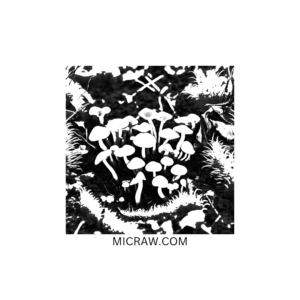Claviceps purpurea is a fascinating ergot fungus that grows on cereal crops like rye, wheat, and barley. This parasitic fungus has played a major role in both agricultural history and modern medicine, especially through its connection to the discovery of LSD by Swiss chemist Albert Hofmann. In this article, we’ll explore the biology of Claviceps purpurea, its toxic and medicinal uses, and how it led to one of the most famous psychedelic compounds.
What is Claviceps purpurea?
Claviceps purpurea, commonly known as the ergot fungus, infects grains such as rye (Secale cereale), causing a disease known as ergotism in humans. The fungus produces sclerotia, dark purple structures that replace the grains and contain potent ergot alkaloids. These alkaloids have a long history of use in medicine but also caused devastating ergot poisoning outbreaks throughout history.
Ergotism: The Dark Side of Claviceps purpurea
During the Middle Ages, outbreaks of ergotism, also referred to as St. Anthony’s Fire, were common in Europe due to the consumption of ergot-contaminated grains. The ergot alkaloids in Claviceps purpurea caused hallucinations, convulsions, gangrene, and even death. This led to major ergot outbreaks that ravaged communities.
Despite its deadly effects, the alkaloids produced by Claviceps purpurea—notably ergotamine and ergometrine—have since become important in medicine, used to treat migraines and postpartum hemorrhages.
The Connection to LSD: Albert Hofmann’s Discovery
In 1938, Albert Hofmann, a chemist at Sandoz Laboratories, was studying the chemical structure of ergot alkaloids produced by Claviceps purpurea. In his research, he synthesized a new compound, LSD-25 (Lysergic acid diethylamide), from lysergic acid, a derivative of ergot alkaloids. LSD was initially overlooked, but Hofmann famously revisited it in 1943, accidentally absorbing a small dose and experiencing vivid hallucinations—thus marking the first LSD trip in history.
This discovery of LSD revolutionized the study of the brain, leading to the rise of psychedelic research and eventually contributing to psychiatric treatments.
Medicinal Uses of Claviceps purpurea
Despite its association with ergot poisoning and the infamous LSD, Claviceps purpurea has significant medicinal applications. The alkaloids derived from this fungus, such as ergotamine, are still used to treat severe migraines. Meanwhile, ergometrine is commonly used in modern medicine to control excessive bleeding after childbirth.
These compounds from Claviceps purpurea showcase the dual nature of this fungus—while it has caused historic plagues, it has also provided humanity with crucial medical compounds.
Claviceps purpurea and Psychedelic Research
The influence of Claviceps purpurea extends far beyond its medicinal use, especially in the world of psychedelic therapy. The discovery of LSD paved the way for modern research into psychedelics as potential treatments for mental health disorders like PTSD, depression, and anxiety. Today, psychedelic-assisted therapy is gaining momentum, with LSD and other substances being studied for their transformative effects on brain chemistry and human consciousness.
Agricultural Impact of Claviceps purpurea
The agricultural impact of Claviceps purpurea also cannot be overlooked. Ergot-infected rye led to significant crop losses throughout history, affecting food supplies and causing widespread famine. Modern fungal management practices now help control ergot outbreaks, but Claviceps purpurea remains a concern for cereal crop farmers today.
Conclusion
Claviceps purpurea is an incredibly influential organism in the worlds of medicine, psychedelic research, and agriculture. Its connection to ergotism and the discovery of LSD by Albert Hofmann has left a lasting impact on human history. Whether as a medicinal fungus or a contributor to the rise of psychedelic therapy, Claviceps purpurea remains one of the most intriguing fungi in mycology.




